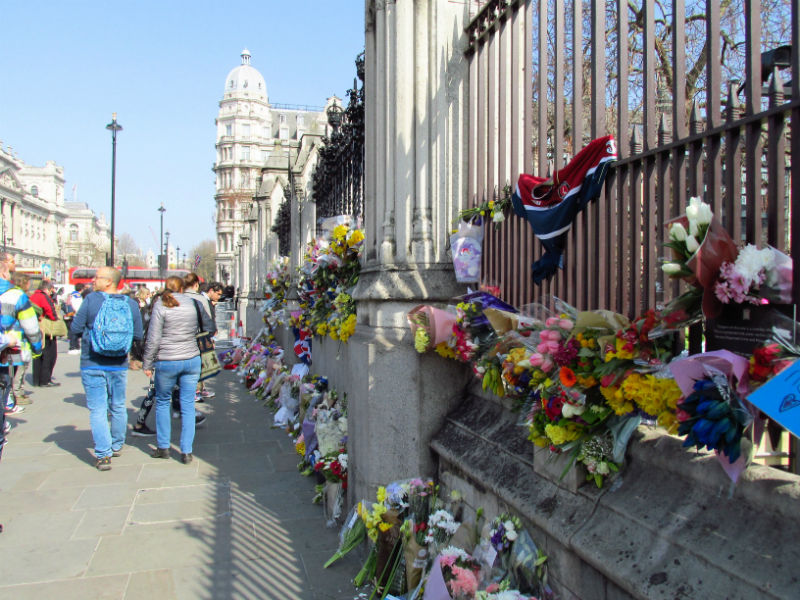 Flowers left at Carriage Gate, scene of the attack in Westminster on March 22nd 2017
Flowers left at Carriage Gate, scene of the attack in Westminster on March 22nd 2017
In its own ghastly and callous fashion, terrorism is an innovative force – constantly ushering in new ways of implementing death and destruction so as to convey a political message. To stay relevant and effective, homeland security services must constantly seek to counter new forms of attack, evolving their processes so as to ‘expect the unexpected’.
This is not easy for large, ‘immortal’ bureaucracies to do, partly because apparently small shifts in techniques used by terrorist groups can have large effects. Most commonly, terrorists (like everyone else) innovate by finding some new way to re-combine elements that are already well-known, but have previously been kept separate. Governments are often terribly slow in perceiving such re-combinations.
For example, the 9/11 attacks put together suicide bomber attacks (a technique with hundreds of examples in the previous decade) with aircraft hijackings, so as to turn the planes themselves into bombs. US authorities had practiced anti-hijacking scenarios just the day before the 9/11 attacks – so recently indeed that some officials could not believe the incident was not a drill. But all their scenarios envisaged hijackings where passengers were held hostage for demands by hijackers anxious to escape and survive, not ones where hijackers were keen to die.
For the London 2017 case, the re-combination was to adapt the ‘truck terror’ technique already used in dreadful Nice and Berlin Christmas market incidents the year before, this time employing a small SUV to mow down dozens of pedestrians and cyclists on the iconic walkway of Westminster Bridge next to Big Ben, as a prelude to a final suicidal assault on the hard target of Parliament itself. The very high casualty toll of this attack owes everything to the fact that the terrorist could drive unimpeded from one end of the bridge to the other, with no barriers of any kind to protect walkers and cyclists from vehicular assault.
Yet both Parliament and all the government departments down Whitehall next door are covered by anti-terror barriers. The Westminster ones are huge, black, and ugly – apparently deliberately left obvious and out-of-place, perhaps as a visual signal to potential attackers not to even try. The Whitehall ones are more subtle – see picture below – with strange, balustraded stone effect walls and bollards, discreetly making it impossible for any vehicle to crash into government buildings.
The purpose of the Whitehall and Parliament barriers is to guard against ram-raider-style efforts at what security sources call ‘penetrative assaults’, by holding vehicles at a safe distance from the building fabric itself. Most of these barriers are in the middle of pavements – so that they protect only the few pedestrians likely to be inside the barrier, not those exposed on the road-side of it.
The UK homeland security services have previously warned of the threats of terror attacks in ‘crowded places’, and a 2012 document officially defines what these are and outlines a number of different kinds of threats. The emphasis is mainly on static events like celebrations or night-scene activities, and nowhere does the advice dwell on the possibility that vehicles will just be used to run down spectators in crowds. Similarly, a 2016 Royal Institute of British Architects advice document focuses only on vehicles as ram-raid objects, not vehicles as ISIS videos have encouraged supporters to see them – as weapons of indiscriminate assaults on ordinary people. Since the Nice and Berlin street attacks, the lags in official advice here look obvious, with hindsight.
Of course, it is always far easier to recognize the ‘unexpected’ after it has happened, but identifying it beforehand is far harder. None the less, that difficult role is exactly what homeland security is for – its key rationale. So why then was Parliament’s security (mostly) effective – although one policeman tragically lost his life – while security on Westminster Bridge next door was apparently so weak? After all, the bridge’s pavement, just below Big Ben itself, is one of the most iconic settings in all of London, and it is, together with Westminster tube station, one of the most obvious ‘crowded places’ in the capital during the day.
It will be vital that these issues are rapidly addressed, and some possible explanations of the high casualty toll this time are fully explored. Often a failure to ‘expect the unexpected’ can be traced back to organizational limits creating gaps in coverage. So was the bridge itself part of the same organizational unit within the police that handled parliamentary security, and perhaps also Whitehall security? Or was responsibility for these high-profile targets so narrowly defined that the bridge actually fell into some other unit’s ambit of responsibility?
Similarly, organizational cultures often impose constraints on homeland security thinking, with each type of organization focusing on doing what it is good at doing, but responsibilities shared with other organizations being de-emphasized. Bridges are exposed settings for walkers and cyclists, placed cheek by jowl with vehicles. Whose responsibility was it to consider in a timely way – after Nice and Berlin – what measures are needed to protect people here? Policing agencies provide intelligence and protective personnel, but they don’t install highway barriers – that is not their thing. How focused, fast and effective was the liaison between homeland security and highway authorities? The fact that the terrorist on 22 March could mow pedestrians and cyclists down across the whole length of the bridge is not reassuring.
Learning lessons quickly from terror attacks is vital in combatting future ones, and in taking immediate steps to prevent further copycat incidents. Longer term, homeland security agencies need to respond agilely and imaginatively, thinking constantly about their own organizational culture, blind spots, and biases. In the 9/11 attacks, dozens of passengers and flight attendants on the hijacked planes tried to contact the police, FBI or anyone in authority using mobile phones and back-of-seat credit card phones. Not one got through, because in the official mindset, all communications to official bodies were routed exclusively through the plane cockpits. No one in authority had realized that tech developments made ordinary passengers a useful source of information. Yet in the end, it was the passengers on United 93 who alone pieced together what was going on, by talking to their families and loved ones, and took the actions that saved the White House or the US Congress from attack.
This article was originally published by the LSE Politics Blog under a CC-BY-NC-ND licence




Rate and Review
Rate this article
Review this article
Log into OpenLearn to leave reviews and join in the conversation.
Article reviews